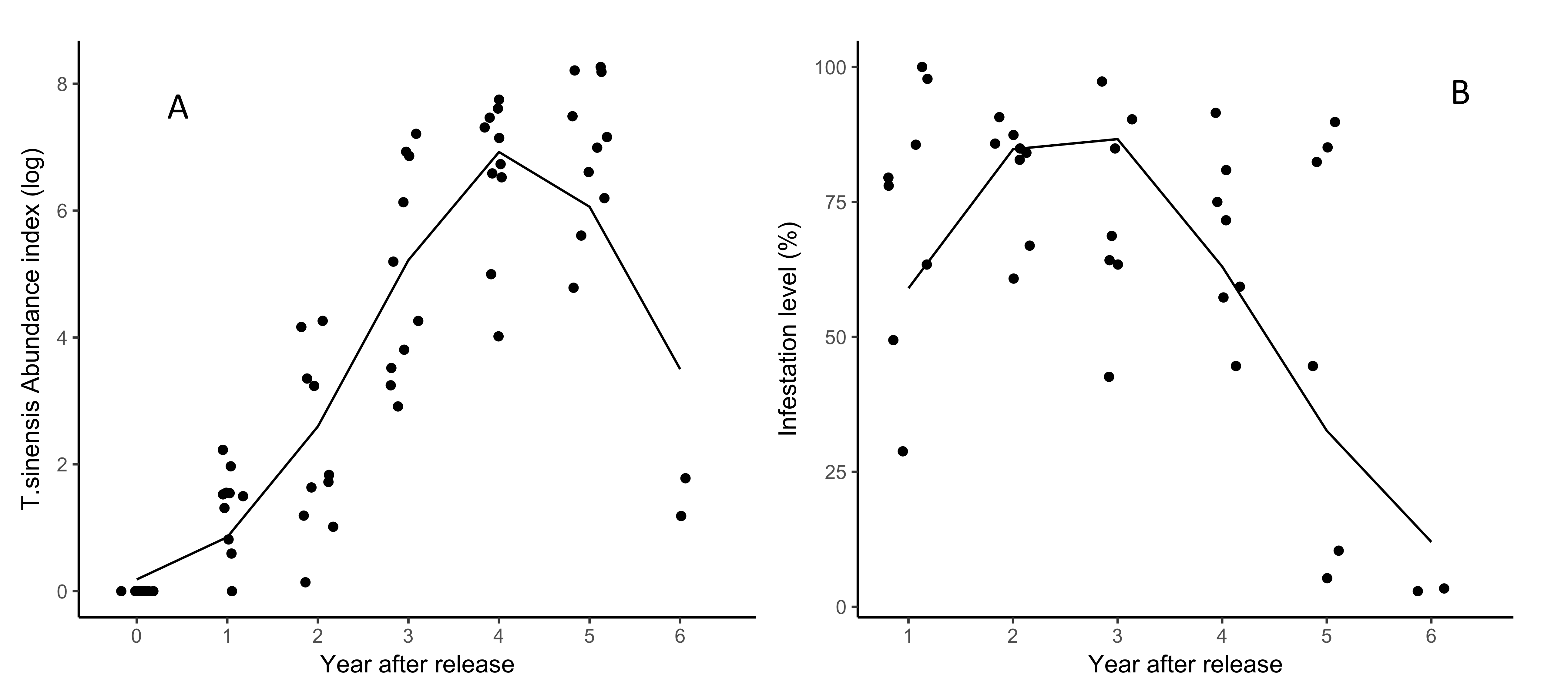
The objective of the project was to implement in France a classical biological program against the chestnut gall wasp, Dryocosmus kuriphilus (Dk), using releases of the exotic parasitoid Torymus sinensis. The expected outcome of this project were (i) the permanent establishment of the parasitoid and (ii) an efficient and long-term control of the pest.
The chesnut gall wasp (Dk) was firstly reported in Japan in the 1940s where it led to a decrease of chestnut production up to 80%. With 1 million hectares located in France, C. sativa is very important for economic, environmental or landscape purposes. Dk was reported in 2010 in several areas of chestnut production in France. To optimize and coordinate actions to fight this invasion, a national committee was created to:
- group together all the stakeholders
- implement biological control using releases of the parasitoid Torymus sinensis (TS)
- document yield losses in order to gain financial supports for producers
Between 2011 and 2015, experimental releases of TS were done on 58 sites in France. Releases were done using several modalities of introduction in order to optimize the biological control against Dk. Following 7 years of post-release surveys, results showed a first exponential growth rate of TS populations with no effect of the modality of introduction during the 4 first years after releases, followed by a decrease of both TS and Dk populations.
Moreover, we also observed a positive effect of the connectivity of the site (presence of oak-chestnut natural stands in the surroundings) on TS population size. This suggests a successful establishment and colonization at a wide spatial scale beyond the introduction sites.
The classical biological control in France showed that TS is an efficient biocontrol agent, with a highly active dispersal. Indeed, this parasitoid naturally colonized control sites (i.e. without releases) very quickly. Knowing this dispersal ability, the main recommendation for massive releases was to release small numbers (i.e. 100 females) of TS every 5km.
Control of Dk was achieved around 6-7 years after first releases implemented in France, with levels of chestnut production back to its initial level 6-7 years after first releases.
The levels of control seems depend upon chestnut variety as well as pedoclimatic conditions. In Corsica for example, infestations of Dk are still high, even if a decrease if observed since 2 years.
Due to the impact of Dk on chestnut production, massive redistributions of TS have been implemented by growers only 4 years after the first experimental releases, and thus before the demonstration of the efficiency of TS. This highlights the difficulty to find a good balance between scientific and agronomic aims.
Since high decrease of Dk populations is observed in most areas of chestnut production, no new release of TS is planned, except in areas of honey production. From a scientific aim, we are still analyzing data collected during the 8 years post-release survey: dynamics of TS and native communities, assess the genetic diversity of TS, document potential unintentional effects (hybridization of TS with native Torymus, attack of non-target species of oak cynipid, etc.).
Further information
Borowiec N., Thaon M., Brancaccio L., Warot S., Risso S., Bertoncello E., Quacchia A., Ris N. and Malausa J.C. (2013). Lutte biologique contre le cynips du châtaignier. Phytoma 662, 32-35.
Al-Khatib F., Fusu L., Cruaud A., Gibson G., Borowiec N., Rasplus J.Y., Ris N., Delvare G. (2014). An integrative approach to species discrimination in the Eupelmus urozonus species complex (Hymenoptera, Eupelmidae) with the description of 11 new species from the Western Palaearctic. Systematic Entomology 39, 806-862.
Borowiec N., Thaon M., Brancaccio L., Warot S., Vercken E., Fauvergue X., Ris N. and Malausa J.C (2014). Classical biological control against the chestnut gall wasp Dryocosmus kuriphilus (Hymenoptera, Cynipidae) in France. Plant Protection Quarterly 29, 7-10.
Fleisch A., Thaon M. and Borowiec N. (2017). Parasitoïdes associés au cynips du châtaignier en Alsace. Phytoma 704, 8-10.
Fernandez-Conradi P., Borowiec N., Capdevielle X., Castagneyrol B., Maltoni A., Robin C., Selvi F., Van Halder I., Vétillard F. and Jactel H. (2017). Plant neighbour identity and invasive pathogen infection affect associational resistance to an invasive gall wasp. Biological Invasions. https://doi.org/10.1007/s10530-017-1637-4
Borowiec N., Thaon M., Brancaccio L., Cailleret B., Ris N. and Vercken E. (2018). Early population dynamics in classical biological control: establishment of the exotic parasitoid Torymus sinensis and control of its target pest, the chestnut gall wasp Dryocosmus kuriphilus, in France. Entomologia Experimentalis et Applicata 166, 367-179.
Viciriuc M., Thaon M., Moriya S., Warot S., Zhang J., Aebi A., Ris N., Fusu L. and Borowiec N. (submitted). Contribution of the integrative taxonomy to tracking past and recent interspecific hybridizations between the biological control agent Torymus sinensis and its related taxa. Biological Control.
Website of the biological control against D. kuriphilus in France (https://www6.inrae.fr/cynips-chataignier/)
Nicolas Borowiec - INRAE

Nicolas Borowiec - INRAE
